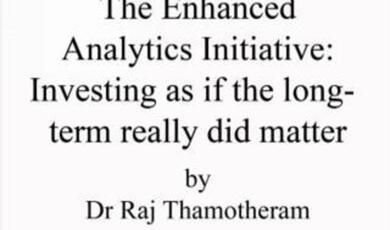Philanthropy New: At the Intersection of Money and Meaning
Share
- Details
- Transcript
- Audio
- Downloads
- Extra Reading
Philanthropy has always been a feature of public life from faith and good works in medieval times to charitable giving today. This symposium looks at philanthropy in its historical context, reviews the work of the great philanthropists of the nineteenth century in particular, and asks what it has to offer in the world today.
Download Transcript
8 November 2012 Philanthropy New: At the Intersection of Money and Meaning Paul Cheng I would like to give a little historical context to social investment. You may have heard of some of the developments in social investment. You may have heard about new financial instruments, social impact bonds, new ways of thinking about deployment of capital for social purpose. I think it is important that we see this in the historical context and think about some of the trends of why social investment is becoming more important now and why are we hearing so much about it. If I could just point to some of the trends that I think are important. As we look back, and we are concerned about creating positive change in society, one question is: how effective is philanthropy? Philanthropy has been around for some time, and there are many social issues that we care about and want to tackle, but if we continue to have these social problems and we are not really eradicating them, the question is begged, are we really being successful or are we actually just being very ineffective at what we do? Also, in the modern context, we live in a very business-oriented society, a consumer society, and the new types of philanthropists who arrive on the stage have made their money in business and take a very business-like approach to all aspects of their lives, including their philanthropy. A number of these philanthropists, in the last fifteen to twenty years, are very different from the types of philanthropists that we have seen before. They have made a lot of money and are relatively young and are not interested in just simply writing cheques. Of course they are going to write cheques, but they are also asking “Are we being effective as philanthropists?” and “Just because you are a charity, I am not going to assume that you are doing good – can you prove to me that you are doing good?”. In other words, there is a focus on outcomes. There is a focus on “Are you being effective?” not just merely on process or merely assuming that if you have charitable status that you are effective. So you have these new types of people coming on the philanthropic stage. You have people thinking about outcomes, thinking longer term about how we can really tackle intractable social issues and also a realisation that perhaps some of the ways that we have been doing philanthropy, when we think about it, are perhaps not particularly smart. So, for example, the three-year project grant, is that really an effective way to solve difficult social issues? Perhaps it would take much longer to tackle some of the fundamental causes of these social problems. Should in fact we consider tackling a social issue like developing a blockbuster drug? A blockbuster drug takes 25 years, from conception, to bring to the marketplace and hundreds of millions to develop. Now, if it takes that long to develop a blockbuster drug, does it seem sensible that we can create solutions to intractable social problems in a three to five year timeframe? You know, perhaps not… So, these thoughts have been entering the world of philanthropy, and a lot of the new philanthropists, with their background in technology, with their background in finance, have been looking at ways of more effectively deploying capital for social purposes and re-imagining how philanthropy can be done. London is emerging as the global centre for social investment. On this chair, you will have this brochure, and the picture on the front is a rather fetching picture of London, and that is really appropriate because London has a history of financial innovation and, over the last twelve years, has really emerged as doing some of the really interesting thinking around new financial instruments for investing in charities and social enterprises, and how we can think of effective ways to augment classic philanthropy and classic grant-making. It is not a replacement for grant-making, but a way of increasing the range or financial options open to charities and social enterprises. One of the key insights of the last twelve years is the fact that we have made a terrible mistake in the way society conceptualises charity finance. We think of charities as begging bowls. The financial analysis of a charity is it is a begging bowl, and when I say the word “charity”, it immediately has a visual for you and the visual is very much a rich man giving to a poor man – it is a begging bowl. A charity is a begging bowl: please give me money; I spend it, I need more money. From a financial analysis point of view, or from an accounting point of view, that is an organisation that merely thinks of itself as income and expenditure, the profit and loss account as it were – no conception of a balance sheet, not much conception of cash flow, little understanding of working capital. But charities are organisations that have to employ people, that have to spend money on overhead, and so is it surprising that they have perhaps the same types of financial needs as perhaps a small business, and yet, we limit charities to one type of financial instrument, the charitable donation, a grant. That is the only way we like to fund them. But why is that? It is very strange, because, in your personal life, you have a range of financial instruments open to you. If you want to buy a house, you have a long-term secured loan, otherwise known as a mortgage, you have credit cards. If you are a company, you can issue debt, you can issue equity. Why is it that, when we enter the world of charities, we limit ourselves to one financial instrument? The reason is because of historical reasons, because we conceptualise charities as a begging bowl. Social investment has come along to try and really resolve some of the inherent financial problems that this creates. In particular, the cash flow/working capital issues of charities is particularly acute. Grants, for example, are normally paid in arrears. So, as a charity, even if you secure your grant, the grant is normally paid in arrears, you do the work first, and then you get paid. Now, if you do not have much of a balance sheet and you do not have many reserves, that immediately gives you a cash flow problem, but it is not a problem that is particularly difficult to resolve. You can get – one capital loan is a bridging loan, you know, if, in the mainstream economy, as a small business, that is what you would do. It is another issue of course, in the mainstream economy, small businesses are also struggling now to get loans. But, as a charity, you should not be forcing a situation where you are constantly struggling, in a subsistence-type economy, thinking about your working capital. You should be focusing on your mission and your social impact, and so what we need is an efficient capital market that connects the financial needs of charity and social enterprises to supplies of capital, to supplies of the social finance capital to resolve these issues, and that is what has been emerging in the last twelve years in the UK and has now been capturing the imagination of other markets around the world: thinking about building a financial ecosystem that enables charities and social enterprises and other social purpose organisations to have the capital and the financial instruments that are needed to fund their work, not just through income and expenditure but also through their balance sheet and working capital needs. So, that is what has been, in an embryonic research and development phase, has been occurring in the last twelve years in the UK, and I liken it to eighteenth century finance. It is very much like being in London in the eighteenth century, when we are thinking about how do we mitigate risk if we are doing long voyages around the world: company limited by shares, these ideas came about through the eighteenth century; the idea of insurance in Lloyds’ coffee houses. Okay, now we work in Costa and Starbucks, and we are now thinking about social finance, but it is interesting that London remains this vibrant centre of financial innovation. In thinking about the ecosystem of finance, so looking at a central bank for social finance, and one of the big developments this year in the UK is the creation of a new wholesale financial institution to fund financial intermediaries, social financial intermediaries – it is called big society capital. So you can see that we are in this very exciting world where a new financial services industry is growing up around charities and social enterprises, and I believe that in fifty to a hundred years’ time, when people look back on this stage, this time, it will be seen as one of the golden ages of social investment. It is a particularly poignant time because the financial crisis has really brought up into sharp relief a lot of these issues. We are trying to, in effect, create an alternative financial system and re-think some fundamental concepts. For example, in social investments, we talk about the balancing of financial and social returns, investing for a financial return, not necessarily a profit-maximising one, and social returns, and thinking about social impacts and positive social outcomes for society. As we think as social investors in this world, we are having to re-think some fundamental concepts: so, the idea of not being profit maximising, but being profit optimising. What does risk mean in the world of social investment? What does risk mean in the world of a mainstream commercial investment? These are very thorny, tricky issues that I think we do need a national debate around, and yet, because they are so difficult, these issues, to think about, that we generally do not have the right national conversation around this, but we should do because I think these are issues that we all really care about. The idea of risk, for example, is a particularly problematic one, in the world of social investment. People naturally think about financial risk when they think about investment, but in the world of social investment, we need to think about other types of risk. So, the concept of social impact risk is something that we need to get our head around. What does that mean? The idea that, if you are investing for a financial and a social outcome, the social impact risk is the probability of you achieving or not achieving the specified social outcome that you aimed to achieve at the outset of the investment. So, how do we think about these concepts and how do we introduce these concepts into our thinking? It is extremely challenging because a lot of our fundamental concepts in finance and in accounting are so deeply embedded that it is going to take a long time to change them. Tim mentioned, or alluded to, the fact that it is very odd that charitable foundations have a tax break, obviously – they get a tax break by having charitable status – and yet, when you look at how they manage their assets, it is very odd because what they do is, most of the assets, the endowments, are put into mainstream commercial investments, and the income from those investments is used for making the grants. But that means we have given, as a society, charitable institutions a tax break, but 95% of the assets are not pursuing any kind of social mission at all – it is being invested in purely commercial markets. Is that a good deal for society? It seems slightly strange. To change this, we have to challenge some very ingrained concepts. Now, leaving aside the concepts in UK accounting, which in itself is a huge topic, but in legal terms, the idea of fiduciary duty – you have to invest to maximise the financial returns of your assets. But that does not admit to anything around social impact. Supposing if you care not just about financial returns but also social and environmental and community returns… So these concepts are not embedded at all in our financial and our accounting systems, and so you can see the scale of the problem. You know, even if we can all agree on the strategy going forward and what we need to do, there are some real, very deep legal problems embedded in the fabric of our society. That is the world of social investment, and there is a small, growing community of us trying to feel our way to develop new institutions, new organisations, new funds, with track records, to encourage more people to come in and join in this movement. I will talk a little bit about Shared Impact. So, Shared Impact is one example, and there are lots of other players in this market, but this is one example of the sorts of things that we are trying to do. Shared Impact is creating a secondary market for social investment products, so there are a number of new social investment products being developed, whether it is community share, social impact bonds, various types of charitable bonds – like Scope, for example, issued a £20 million bond recently. These are really exciting products, but for members of the general public, you really cannot get involved in any of this at the moment. It is only open really to high net worth individuals and institutions. And yet, the general public is the most significant source of charitable funds, so the general public gives away, you and I, £10.6 billion every year to charity, roughly £10.6 billion into collecting tins, into payroll giving, charitable donations, that is £10.6 billion, including some gift aid, and not everyone claims gift aid, which is another issue. £10.6 billion versus foundations giving grants of around £4.5 billion. So, you can see, the general public is a significant source of funds, but it is highly fragmented. What Shared Impact and others are trying to do is to create platforms that allow the aggregation and participation of the general public into social investment, and we are already seeing other types of aggregating online platforms that show that this works. If you can really create efficient online platforms that are compellingly marketed and well-designed, there is real hunger for people to really invest in these things, and, ultimately, we want the pension funds and your savings to be so you can deploy these into social investment if you so wish. So, for example, in the future, perhaps it is some way off, but why cannot you direct your pension fund into investing in your local community for financial return, but also for the social impacts? It is going to take time to develop this. It is a new financial services industry, as I say, and we are having to – the analogy I give, it is a bit like starting an Internet company but you are having to build the Internet as well, at the same time. So, it is quite challenging, and we are having to bring together a whole team of people who are not normally considered to be a part of the charity sector, so people from technology, people from the financial services industry, people from behavioural economics, to actually look and design these new products and services. It is a really exciting time, but it is a huge challenge. The UK is leading the way, followed closely by the United States, and, like a lot of British innovations, I suspect the United States will eventually scale up a lot of the innovations that we develop here. It is really also pushing other countries, with very different cultural contexts, to think about philanthropy and about deployment of capital for social purpose, in ways that I think are challenging the traditional ways of philanthropy and international aid, for example. For example, with international aid, there has been criticism about international aid, about how effective it is – is it, to a large extent, an industry that is very much serving itself, and is it also very neo-colonialist in that, it is very patronising that aid, for example, is going from the West to developing countries, and should we not be perhaps helping in-country support and helping people to help themselves. So there are these trends also beginning to take off. I think there is also a general shift happening as well. People in there twenties, for example, view philanthropy and view their civic engagement in perhaps very different ways. I think there is a huge generational gap and a lot of disillusionment between generations at the moment, and I think young people are getting very much involved in entrepreneurship and social entrepreneurship, and I think that the way they engage in philanthropy is going to change dramatically over the next ten to twenty years. I think there is a lot of misunderstanding about young people and philanthropy. There has been some debate in the sector recently about the fact that older people tend to give more to charity and young people are not so interested, and I question whether that is really true. People say that young people do not give to charity, and often, it is not that they do not give to charity, but often the medium is important. So, it is true that young people do not give to charity by cheque, but they do by SMS text donation. What do we think about philanthropy and social media, and the new technologies, and how do we engage young people? I think the future of charitable fundraising, for example, is going to look a lot like the Obama political campaign. The way the Obama campaign uses technology and social media, and to data-mine to really understand their constituents, are the sorts of techniques that we will see growing for charitable fundraising. I think all these trends are beginning to blend and, in some ways, clash, and we will see these as the drivers of the new philanthropy over the next ten to twenty years, and it is a really exciting time as all this develops, and I think it also reflects the nature of the new society and the modern society that we live in. As consumers, we expect choice and we expect information and control, and everything at the click of a mouse, and that we expect in all aspects of our lives, and I think philanthropy and the charity sector has been somewhat slow in realising this, but it is gradually changing, these are the drivers of the biggest changes and the sort of seismic shifts that are happening in philanthropy over the next twenty years. Thank you. © Paul Cheng 2012
This event was on Thu, 08 Nov 2012
Support Gresham
Gresham College has offered an outstanding education to the public free of charge for over 400 years. Today, Gresham plays an important role in fostering a love of learning and a greater understanding of ourselves and the world around us. Your donation will help to widen our reach and to broaden our audience, allowing more people to benefit from a high-quality education from some of the brightest minds.


 Login
Login







